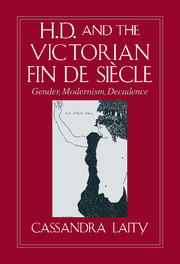Book contents
- Frontmatter
- Contents
- Acknowledgments
- Introduction: Dramatis Personae: The Aesthete Androgyne and the Femme Fatale
- 1 The Rhetoric of Anti-Romanticism: Gendered Genealogies of Male Modernism
- 2 H.D.'s Early Decadent Masks and Images: HER; Sea Garden
- The Aesthete Androgyne
- 3 Writing the Decadent Boy Androgyne: Whiteness, Diaphaneitè, Poikilia, and Male Statuary
- 4 Across Gender, across Sexuality: H.D.'s Male Masking and the Sexual Narrative: Hippolytus Temporizes; “Heliodora”
- The Femme Fatale
- Postscript
- Notes
- Index
- CAMBRIDGE STUDIES IN AMERICAN LITERATURE AND CULTURE
4 - Across Gender, across Sexuality: H.D.'s Male Masking and the Sexual Narrative: Hippolytus Temporizes; “Heliodora”
Published online by Cambridge University Press: 06 January 2010
- Frontmatter
- Contents
- Acknowledgments
- Introduction: Dramatis Personae: The Aesthete Androgyne and the Femme Fatale
- 1 The Rhetoric of Anti-Romanticism: Gendered Genealogies of Male Modernism
- 2 H.D.'s Early Decadent Masks and Images: HER; Sea Garden
- The Aesthete Androgyne
- 3 Writing the Decadent Boy Androgyne: Whiteness, Diaphaneitè, Poikilia, and Male Statuary
- 4 Across Gender, across Sexuality: H.D.'s Male Masking and the Sexual Narrative: Hippolytus Temporizes; “Heliodora”
- The Femme Fatale
- Postscript
- Notes
- Index
- CAMBRIDGE STUDIES IN AMERICAN LITERATURE AND CULTURE
Summary
This chapter continues to inquire into the literary, political, linguistic, representational adventures issuing from female modernist uses of the Decadent boy androgyne. H.D.'s maternal-erotic quest romance, Hippolytus Temporizes, perhaps best illustrates H.D.'s deployment of the male mask, the open sexual narrative, the white body of androgyny, and Romantic twinning she derived from Victorian Hellenism. Before discussing the play, however, it will be useful to survey and elaborate upon the Decadent conventions related to the male Aesthete that most attracted H.D. and her contemporaries. Why might a modernist woman writer deploy a culturally stigmatized and (frequently) literally outlawed form of sexuality to explore female desire? How might Decadent male–male homoerotic literary conventions and codes offer better models for the unity of eros, intellect, and legitimate political power than those available in modernist (heterosexual or lesbian) imagings? What might the strategy of adapting the Decadent boy mask afford a lesbian or bisexual writer?
The Male Aesthete as Fair Youth or Wildean Prototype and Modernist Woman Writers
“Art is Individualism and Individualism is a disturbing and disintegrating force,” Oscar Wilde wrote in The Soul of Man under Socialism. Jonathan Dollimore demonstrates that Wilde's definition does not concern human essences but “is inseparable from a transgressive desire and a transgressive aesthetic.” Thus, if male modernists rejected the male Aesthete in the name of impersonality, many women writers found reason to embrace the Wildean persona of the sexually transgressive artist/narrator. Famous Wildeanisms including Wilde's Aesthete pose, his suggestive aphorisms, and the phrase, “the love that dare not speak its name,” associated with Wilde (although Lord Alfred Douglas originated it), became the identifying features of the sexually heretic authorial mask.
- Type
- Chapter
- Information
- H. D. and the Victorian Fin de SiècleGender, Modernism, Decadence, pp. 84 - 112Publisher: Cambridge University PressPrint publication year: 1996



